Answer
Oct 10, 2024 - 01:46 PM
Class A audio amplifiers operate with their output transistors always on, providing high linearity and low distortion but with low efficiency and significant heat generation. In contrast, Class D amplifiers use pulse-width modulation to switch the output transistors on and off rapidly, resulting in higher efficiency, less heat, and typically smaller form factors, but can have more complex circuitry and potential for higher distortion if not properly designed.





Add New Comment